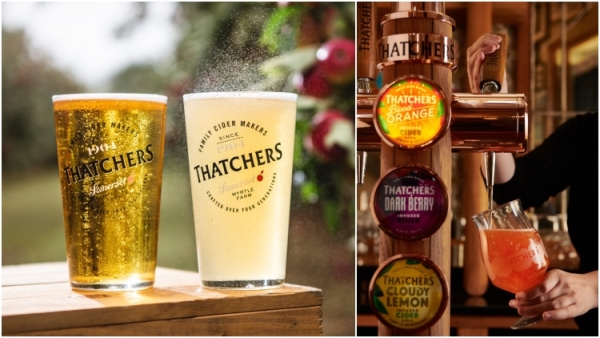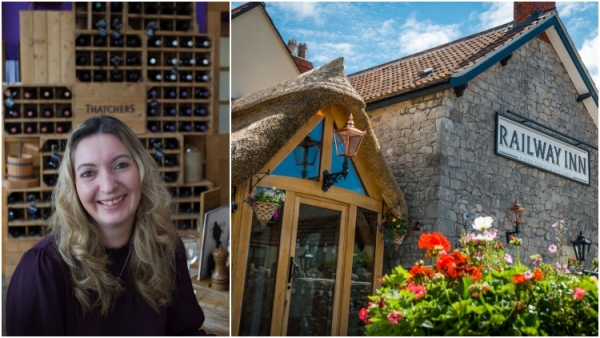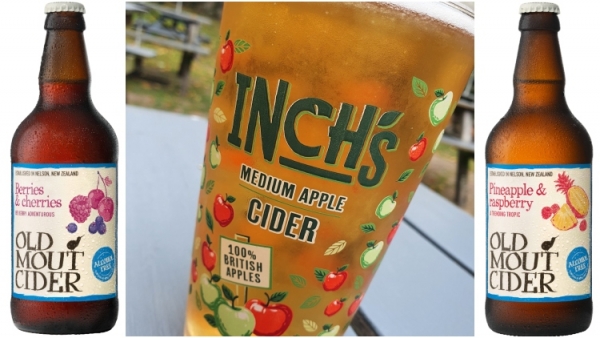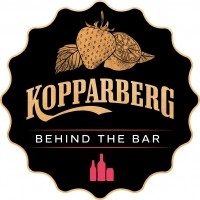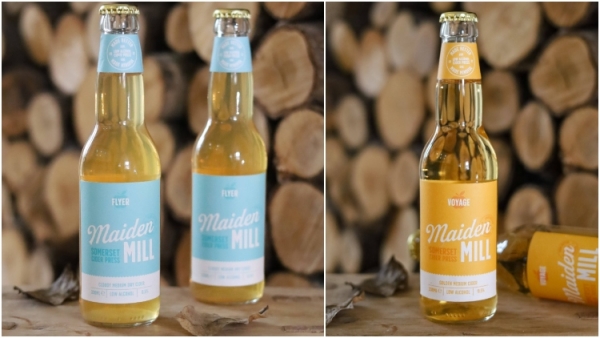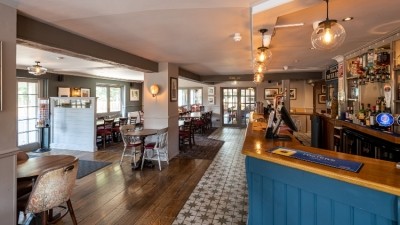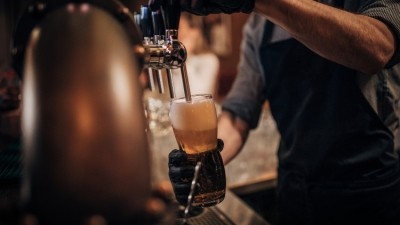Feature - cider
FEATURE: Become the ‘go-to’ for a cider or two
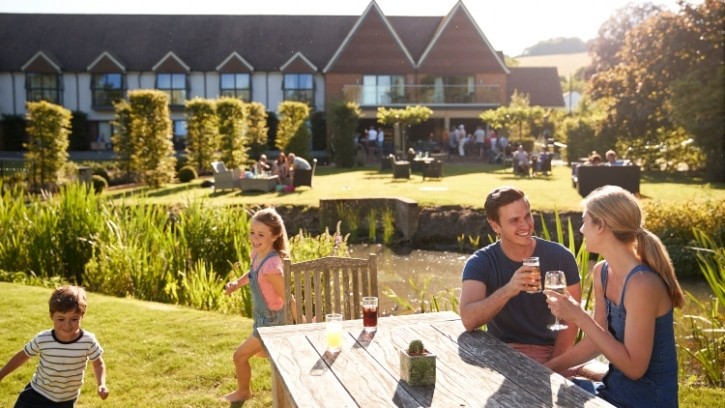
Promotional content - Thatchers Cider
Publicans make their free choice as Thatchers Gold takes the top spot
Thatchers Gold has become the #1 cider in the GB licensed free trade, taking the top spot for the first time.1
With its perfect balance of fruitiness, tannin, sweetness and acidity, crafted with the very best tasting apples by Thatchers Cider, this is the draught cider that pub operators turn to for quenching their customers’ thirst.
Thatchers Gold was first produced by the family cider maker some twenty years ago, and since then has seen consistent sales growth across the country, sold on draught in pubs and bars across the UK.
Thatchers Gold now has the highest Rate of Sale for any cider on the bar across GB licensed free trade outlets, more than double that of its closest competitor.
With free trade outlets making up 45% of total cider volume across the country, this tells us loud and clear that where pub operators have the freedom to choose their cider range, Thatchers Gold, with its perfection in every drop, is their preferred pint to drive sales at the bar.
Across total GB outlets, Thatchers Gold retains its existing number one position for Rate of Sale1.
“The appeal of Gold starts right here at Myrtle Farm,” says Thatchers head of on-trade James Palmer, “where we craft Gold with the very best-tasting apples. We have a saying that the best cider starts in the orchard, and that’s exactly the case with Gold.”
Thatchers Gold is supported by an impactful marketing campaign that truly reflects Gold’s refreshing appeal.
Visit Thatchers Cider here for more information.
Source: 1 CGA OPMS P02 25.2.23
As the market recovers post-Covid, and we enter another summer in which many people switch to their ‘sunshine’ drink, perhaps it’s time to start giving cider a bit more thought.
Walk into the Railway Inn at Sandford and you’ll find an approach that’s as refreshing as the golden liquid itself. Cider pumps take centre stage on the bar, with a choice of mainstream and lighter styles, traditional ciders on handpump and a variety of flavours. And there’s a list of cider cocktails. The beer is shunted to one side to make way.
Three is the magic number
When it comes to cider, you might divide your customers into three types: dabblers, fairweather drinkers and regulars. At least that’s the way Thatchers head of marketing Philip McTeer sees it.
“Regulars account for 80% of sales,” he says, “and that’s where Thatchers Gold, for instance, competes with other ciders.
“Fairweather drinkers associate cider with the sun or with occasions such as the rugby or festivals. Our mission is clear with them – how do we get them to drink cider all year?
“Dabblers are 5% of the market. They’re trying lots of different things and want something new and interesting. They might drink cider only once or twice a year, and it tends to be fruit. We’ll be targeting them with our Blood Orange variant this year.”
Of course, the reason is it’s owned by Thatchers, and it’s next door to the cider maker’s Somerset headquarters. But it’s still a working pub with a full range of food and drink, and it suggests what might be possible.
“We’re known for our extensive cider range and that’s a reason many people visit us,” says manager Leigh Damerell (pictured below). “Here we include well-known brands like Thatchers Gold and Thatchers Haze, limited-edition ciders such as Thatchers’ Cider Barn range and three flavoured ciders through our new Fusion font.
“We serve them in pints, halves or flights if people want to try different styles – that’s really popular and a great introduction to our cider menu.
“We find cider cocktails are increasingly popular, too, and we create our own twists on the classics. Gin is always a best seller, so we make our own gin cocktail with our Cloudy Lemon Cider – which is also great in a Vesper.
“There are many ways to introduce customers to our ciders. We suggest cider pairings for our restaurant menu and our chef incorporates cider into a lot of dishes. We keep coming up with new ideas which means the menu stays fresh and seasonal, and that’s what people love.
“From our experience it’s important to stay relevant, know the demographic of your customers, and cater for them with a cider range that suits them.”
Just the stats
According to CGA data, the UK on-trade cider market hasn’t quite recovered to pre-Covid levels, but it’s growing, driven by premium ciders which are up 12% in value on three years ago against standard ciders, which are 13.3% down. Premium’s share of the market is now 45%.
Draught is also running ahead of packaged and now accounts for more than 70% of sales by value and 75% of volume.
Apple ciders are winning back share from fruit flavours and have returned to where they were in value in 2020. Perry sales have collapsed, however, by 46%.
What other pubs can, perhaps, learn from this is that drinkers are expecting more from a pub’s cider offer.
“Their experience at home, during lockdown, means they want different products at the bar,” says Thatchers’ insights manager Gemma Pym. “Look at the growth of world beers. Cider should be doing that in pubs, constructing a ladder that takes consumers from mainstream to premium-plus brands in line with what we’ve seen in lager.”
While Thatchers Gold has become the best-selling draught pint in the south-west, overtaking beer for the first time, the company has also found success with Haze, which claims number one spot in the cloudy apple category. As well as a premium positioning, Haze appeals to another trend, for easy drinking.
“Rate of sale of premium segments drop as consumers see the price jump as a barrier to entry.”
“We saw a market for it with the rise of hazy craft beer,” says James Palmer, head of on-trade at the firm which is also shaking up fruit ciders with its Fusion font, now found in 2,000 pubs where the ‘traffic lights’ attract drinkers to a choice if three flavours, currently Blood Orange, Cloudy Lemon and Dark Berry.
The system allows for the range to change according to market trends, and there is already a move away from berry fruits to lighter, citrussy flavours.
“People need options, and we’ve seen that Fusion is bringing in new drinkers,” declares Palmer. “Our research with a national pubco has shown that it grows a pub’s overall draught sales by 14%, which suggests people are staying for another.”
Case study
London Cider House
In the middle of buzzing Borough Market, one of the capital’s great foodie destinations, the London Cider House is a showcase for all that’s best in cider – and gives pubs a glimpse of what’s possible.
Behind it are three cider makers – Oliver’s Cider & Perry, the Fine Cider Company and New Forest Cider.
Felix Nash of the Fine Cider Company reports the Cider House is “going from strength to strength. It even did well over the winter, proof good cider can transcend summer with styles to suit all seasons, just as with wine.
“We appeal to a broad demographic, but especially anyone interested in exploring drinks, discovering new depths. Craft beer and natural wine have opened the minds of younger generations to such things, but cider has a lot to offer the older wine/beer drinker too.
“A lot of people drink cider but the mass market stuff tends to be similar so they only have it so often. Then they come here and discover many styles. It's like stepping into a whole new world of possibility.
“So for our managers and staff, knowledge is key. It can be hard to get to know much about cider bur Gabe Cook, the Ciderologist, runs some really good courses. And staff simply tasting things for themselves makes things relatable.”
When it comes to mainstream pubs, Nash believes the first step is “getting out of the mindset that cider is just one thing”.
“The ordinary pub can go local. There's loads of new, small cider makers appearing all over the country. It might mean getting a 20-litre bag-in-box you can connect to a hand pump or running a cider festival. You could even experiment with some big sharing bottles or swapping the sparkling wine for a sparkling cider if you sell a spritzer.
“But you have to bear in mind this kind of cider will be new to most people, so it takes effort, and thought, to get it right. Letting people taste things is often the best way, and we do flights from 750ml bottles that allow people to try four different ciders in modest glasses.”
Pricing warning
Despite the premiumisation trend, at Heineken UK, which leads the market with brands such as Strongbow, Inch’s and Strongbow Dark Fruit, on-trade category director Charlie Fryday warns “it’s only in the most upmarket venues that premium apple ciders, like our own Orchard Thieves, should be stocked”.
“Rate of sale of premium segments drop as consumers see the price jump as a barrier to entry. This is less of a challenge where customers expect to pay more for a top quality experience, and a cider range can start higher up the pricing ladder and take advantage of premium’s growth.”
She continues: “However, this isn’t necessarily the case for flavoured cider, with both mainstream and premium brands performing well on draught across high street bars and premium locals.”
Pubs should also prepare for a summer surge in packaged cider, he says, with 30% of consumers more likely to choose a bottle from the fridge as the weather warms up.
“It’s good to focus on breadth of flavours to maximise choice rather than doubling up on similar flavours. With almost half of cider drinkers willing to trade up, premium flavoured ciders such as Old Mout can boost revenue, but don’t forget a trade-up apple cider option in the fridge, too.”
Promotional content: Kopparberg
Kopparberg launches on-trade website to help outlets drive sales
With more young adult drinkers than any other brand1 (18 to 24-year-olds), Kopparberg is well positioned in the market to launch this platform; giving venue managers the tools to unlock this key audience and drive sales in their venue. And as industry leaders in the fruit cider category, Kopparberg can also offer advice and insights for their venues.
In an increasingly challenging industry, Behind The Bar has been designed to equip bar managers and owners with the knowledge and tools to drive behaviour change; Kopparberg’s Behind the Bar website features brand and category insights, digital assets, recipes, serving tips, and product information with the aim of driving footfall, increasing dwell time in venue, encouraging trade up and ultimately driving sales
A key function of the site, which focuses on helping customers grow their business, provides stockists with sales information and tools to make the most of Kopparberg in their bar. Additionally, the Kopparberg point-of-sale hub will simplify access to POS by allowing venue owners to request and have items delivered directly as and when they need it.
To sign up for free, head to Kopparbergbehindthebar.co.uk.
Source: 1. Kantar, Total Market, Fruit Cider, Buyers, 52w/e to 25/12/22.
Joe Dunnett, on-trade activation manager at Kopparberg, which has just introduced Summer Punch, infused with peach, agrees.
“Our core flavours are still Strawberry & Lime and Mixed Fruit, which, though there’s been some decline, continue to give us significant volumes and a big proportion of our sales. People now are looking for something a bit different, though, more niche, so pubs should give some extra space and visibility to new products.”
Draught fruit provides an opportunity to create a point of difference this summer, he believes. “And there’s the option of selling a higher priced pint – but it’s got to be a perfect serve. Customers are more savvy and want an elevated experience, so it must be in branded glassware with lots of ice.”
At Westons, which celebrated a record year in 2022 with sales of Stowford Press growing strongly as the on-trade bounced back, head of marketing Sally McKinnon describes the cider category as “a crucial one for operators to get right - it’s no surprise that venues with the most impressive cider sales are alert and responsive to trends”.
“The success of Stowford Press represents larger category-wide shifts with apple stealing share from fruit and draught cider continuing to grow. While multiple fruit options can be ranged in the fridge to give drinkers a choice, it’s key that venues lead with the right apple brands.
“Looking more closely at apple cider, premiumisation is driving sales,” she continues. “As consumers have grown more health conscious, the notion of drinking fewer, higher-quality draught serves has accelerated.
“What’s more, we expect this trend to gain momentum as people visit pubs less frequently but treat themselves to an affordable trade-up on draught when they do. Brands that can lean into their provenance and craftmanship well be the most appealing.
“Duty changes coming down the track in August could create some exciting opportunities for cider,” she adds. “There is potential for more innovation below 3.5% abv, and for the on-trade draught relief means getting the right cider options on tap – including premium mainstream or crafted trade-ups, will become more crucial.”
Meanwhile, summer “presents a great opportunity to capitalise on impulse purchases. Bag-in-box is an ideal choice here, as it lasts for six weeks with no equipment needed.”
Crafty move
Urban, crafted ciders might also come into your mix. BrewDog subsidiary Hawkes Cidery is inspired by the craft beer revolution to do something similar for cider and attract new drinkers into the category.
According to general manager Elliot Allison (pictured right), “our biggest competitors are not ciders but modern innovative drinks such as craft beer, natural wines and flavoured gins”.
It’s still largely a big city phenomenon, however. Half of Hawkes sales are in London, while a platform in BrewDog’s bars takes the brand into metropolises across the world. But Allison believes that if you’re selling craft beer, you could also be selling crafted cider.
“The crux of our message to mainstream pubs is to think about your cider range, coordinate the whole offering. Cider is often just tacked on, which certainly frustrates me as a cider drinker.
“Alongside that you have to educate customers and staff about quality, explain why it’s better. Crafted cider is more expensive, but people are not told why.”
Focused on innovation, Hawkes has lately launched a Pineapple Punch Cider on draught, and tips sour cherry to be the big cider flavour of the summer. It has also introduced an eight-month-old bourbon barrel-aged cider and is working with mead maker Gosnells on a toasted honey cider.
As Allison says, cider is a most versatile drink, and the company’s Bermondsey taproom is reintroducing cider flights and masterclasses for customers to get them up to speed with the possibilities.
Dropping the alcohol
With the major cider firms already seeing success with low and no-alcohol versions, the market has now welcomed the category’s first brand dedicated to alcohol-free.
Its co-founder Ed Reed noticed independent cider makers weren’t making the same inroads into the alcohol-free category, so developed Maiden Mill to appeal to increasing numbers who choose not to drink, or to vary their repertoire. The brand offers two bottled styles: Flyer, a medium dry cloudy, and Voyage, a medium golden sparkling.
“While Portman Group research suggests consumers are most likely to choose a brand they know for their first alcohol-free drink, figures show this is often a gateway to exploring the category with full-bodied taste, authenticity and sustainability at the heart of their search,” says Reed.
With Maiden Mill’s ciders made with Somerset apples grown within a 25-mile radius, he believes summer is the time for pubs to offer an alternative with such sustainable credentials.
Kentish Pip turned to modern styles after starting out selling traditional bag-in-box ciders a decade ago. Inspired by craft beer it rebranded in 2016 and switched its focus to draught, launching sparkling ciders, such as Skylark, with bright, contemporary designs.
“We began taking a more considered approach with the possibility of broadening the offering with different styles,” explains managing director Sam Mount. “That in turn makes it possible to pair ciders with food, different occasions and demographics.”
“There is more interest in cider from beer drinkers now.”
Mount continues: “People want something new and different. It used to be either scrumpy or mainstream, but it’s much more now. You can go on a journey of discovery, from fresh bright ciders to traditional styles and hybrids.
“There is more interest in cider from beer drinkers now,” he continues. “Some will drink a cider rather than a beer, say, one time in five, but they’re pretty bored with standard ciders so pubs need to offer them something better, a ladder up, a spread of range.
“Even if you stock just two apple ciders, on draught or in the fridge, and you make sure they’re not identical, then you can start to point out the differences. The challenge is to get people to taste them. At our own venue on the farm we offering tours and tasting events, and ideas for food pairing.”
Case study
The Carpenters Arms, Westrip
With spectacular views over the Stroud Valley, you could forgive the Carpenters Arms for depending solely on its location. But since taking over the freehold of the pub shortly before the pandemic struck, Sam McKie (pictured above) has turned it into a cider emporium that’s been named by Camra Gloucestershire’s Cider Pub of the Year for 2023.
“It’s a massive accolade,” she says. “And it comes down the fact that we like cider.”
“I grew up in the village and I’ve always had links with farmers and rural producers. We shop local and we go for variety. There are 45 ciders on at the moment, and at any one point we’ve at least 25 different varieties, including a lot of perry.
“There are always a few favourites on, then we mix it up. People will look for something new. We also have a couple of well-known brands on tap, but the local Just Pressed Blindside outsells Stowford Press.
“It’s about having a conversation with people. We offer them samples, help them whittle down the choice, and suppliers contribute to the staff training that enables that.”
The pub hosts regular tastings with producers and the kitchen comes up with plenty of dishes using cider including a sausage casserole, sausage rolls and a cider cake. It staged its first cider festival in May and its success means it will become an annual event.
Now McKie plans to convert the restaurant into a cider lounge and planting apple and pear trees in the beer garden.

